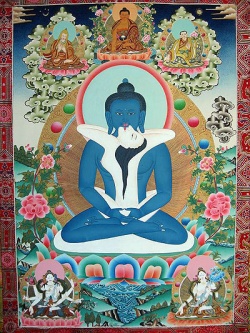4 Types of Birth
4 Types of Birth: Womb, Egg, Moisture / Heat, Apparitional / Miraculous.
In Buddhism, Jāti (the Sanskrit and Pāli word for "birth") refers to the arising of a new living entity within saṃsāra (cyclic existence).
Jāti is identified with the Buddhist teachings in the following contexts:
as an aspect of dukkha (suffering) within the teachings on the Four Noble Truths
as the eleventh link within the Twelve Links of Dependent Origination
Within the Four Noble Truths
Within the teachings on the Four Noble Truths, jāti is identified as an aspect of dukkha (suffering). For example, The Discourse That Sets Turning the Wheel of Truth states:[a]
"Now this, monks, is the noble truth of dukkha: birth (jati) is dukkha, aging is dukkha, death is dukkha; sorrow, lamentation, pain, grief, & despair are dukkha; association with the unbeloved is dukkha; separation from the loved is dukkha; not getting what is wanted is dukkha. In short, the five clinging-aggregates are dukkha.
Ajahn Sucitto explains the difficulty or suffering (dukkha) involved in birth from the Buddhist point of view:
How is birth difficult, or how does it involve suffering? Well, giving birth is physically painful; and also birth is appearance into an uncertain realm. Notice how babies suffer: coming into the world must be a desperate and frightening experience. For the majority of beings, including people in the world today, it means the end of guaranteed nourishment and the beginning of the struggle to survive. Even for the small percentage of privileged humans who live in affluent societies, with birth begins a life in which some physical discomfort is guaranteed, along with the need to sustain or defend the comfort, the property, and the health that they do have. In every case, the obvious long- or short-term consequence of birth is death—the ultimate trajectory is an unavoidable decline. So whatever the joy that comes as a result of birth, birth includes an element of suffering or stress that will arise sooner or later. Birth can also be viewed as “the unfulfilled,” which seeks fulfillment. That is, birth is the beginning of need, a shadow-mood that accompanies anything that arises.
Within the twelve links of dependent origination
The 12 Nidānas:
Ignorance
↓
Formations
↓
Consciousness
↓
Name & Form
↓
Six Sense Bases
↓
Contact
↓
Feeling
↓
Craving
↓
Clinging
↓
Becoming
↓
Birth
↓
Old Age & Death
Jāti is the eleventh of the Twelve Nidānas, is conditioned by becoming (bhava), and is the condition for the arising of old age and death (jarāmaraṇa) in a living being. That is, once a being is born, it will necessarily grow old and eventually die.
Forms of birth
In traditional Buddhist thought, there are four forms of birth:
birth from an egg (Sanskrit: Andaja; Pali: Aṇḍaja; Chinese: 卵生; Standard Tibetan: Sgongskyes)—like a bird, fish, or reptile;
birth from a womb (Sanskrit: Jarayuja; Pali: Jalābuja; Chinese: 胎生; Standard Tibetan: Mnal-skyes)—like most mammals and some worldly devas;
birth from moisture (Sanskrit: Samsvedaja; Pali: Saṃsedaja; Chinese: 濕生; Standard Tibetan: Drod-skyes)—probably referring to the appearance of animals whose eggs are microscopic, like maggots appearing in rotting flesh;
birth by transformation (Sanskrit: Upapaduka; Pali: Opapatika; Chinese: 化生; Standard Tibetan: Rzus-skyes)—miraculous materialization, as with most devas.
Within the Buddhist discourses
Jāti is identified within the Buddha's first discourse, The Discourse That Sets Turning the Wheel of Truth, as an aspect of dukkha (suffering):
"The Noble Truth of Suffering (dukkha), monks, is this: birth (jati) is suffering, aging is suffering..., death is suffering, association with the unpleasant is suffering, dissociation from the pleasant is suffering, not to receive what one desires is suffering—in brief the five aggregates subject to grasping are suffering."
Elsewhere in the canon the Buddha further elaborates:
"And what is birth? Whatever birth, taking birth, descent, coming-to-be, coming-forth, appearance of aggregates, & acquisition of (sense) spheres of the various beings in this or that group of beings, that is called birth."
The canon additionally attributes to King Yama a mundane encapsulation of birth's suffering:
"Good man, have you never seen in the world a young tender infant lying prone, fouled in his own excrement and urine?"
